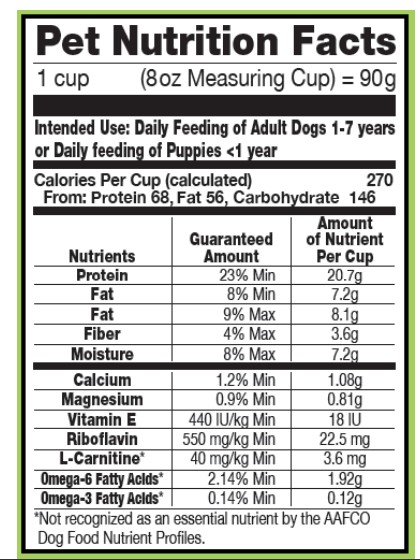Well, there is good news on this front! The Association of American Feed Control Officials (AAFCO) published their proposed changes to pet food labels recently and the public comment period ended on October 31st. These new changes have been in the works since before 2018 and, if approved, would be added to the AAFCO model regulations, which are published yearly. These changes even after approval wouldn't be implemented immediately – manufacturers would likely have several years to get in full compliance. However, as they have been in the works for so long, it's likely that many manufacturers are anticipating the changes and so, if approved, we could start seeing new labels come out relatively soon after the final guidelines are published (which could be as soon as 2023 or 2024).
With the caveat that these are just proposed changes, here are some of the highlights:
1- The Guaranteed Analysis will be replaced with a white box called 'Pet Nutrition Facts' that is designed to look like the 'Nutrition Facts' box on human foods. This box will include the calories per cup or can or other common unit, how many calories come from protein, fat, and carbohydrate, and the amounts of protein, fat, fiber, and moisture plus any additional nutrients that the manufacturer wants to highlight.
{{editor}}
There will be variations for different size packages, but the example below would be similar to what would be seen on most dry food packages.While I'm all for additional information and a more standardized format, the proposal to provide nutrient concentrations based on cups or cans or other volume units is really frustrating as comparing the amounts of nutrients between 1 cup of two different dry foods, or between 1 cup of dry food and a can of wet food will be useless if the foods provide different amounts of calories in that same volume unit! In previous posts, we've explained why the best way to compare nutrients between foods is on a calorie or energy basis, and these new labels are an opportunity to 'do it right' that AAFCO seems to be ignoring.

AAFCO mockup from 2018. Since then, the 'intended use' line has been removed, but the rest is similar in the latest proposal
2- More clarity on nutritional adequacy. We're discussed 'AAFCO statements' or 'nutritional adequacy statements' before – they are the one item on a pet food label that lets you know whether the food contains all essential nutrients for a particular life stage of a pet. Instead of playing hide and seek with the statement on a large bag full of marketing or in micro print on a small can, it has been proposed that manufacturers will include specific icons on the front of the package to make it clear from a glance whether a product is complete and balanced and for what life stages it is appropriate. If a diet isn't nutritionally complete, such as a treat or a food topper or mixer, this will also be clearly stated. This is a very welcome change as there are a number of diets currently on the market that are not nutritionally balanced, but are labeled in a way that can mislead consumers into thinking that they are balanced.
3- Fiber concentrations on the new label will reflect total dietary fiber, like on human foods, rather than crude fiber. This really excites nutrition nerds like me because crude fiber measurements include less than half of the fiber in some foods, so it is a poor choice to use to compare foods and nutritionists have been complaining about crude fiber for years! Total dietary fiber is a much more accurate measurement of the fiber in a diet.
4- Changes in rules for large breed puppy diets that have undergone feeding trials. Currently, diets that are labeled as being appropriate for large breed puppies (over 70 lb adult weight as defined previously by AAFCO) can either be 'formulated to meet' the AAFCO nutrient profiles for large breed puppies, which put an additional limitation on the calcium concentration compared to diets for smaller puppies, or they can complete a feeding trial. However, that feeding trial is not currently required to be in large breed puppies nor is the calcium required to be limited as in diets that are 'formulated to meet' for large breeds. The new proposed regulations will close that loophole by giving manufacturers the choice of doing a feeding trial in large breed puppies, or doing a feeding trial in smaller puppies but meeting the calcium guidelines in the AAFCO nutrient profiles for large breed growth. While I'd prefer a requirement to use large breed puppies in feeding trials for large breed puppy diets, this change will be an improvement from the current regulations.
5- Instructions for safe handling. Packages will now require the safe handling instructions to be included, which could be in the form of standardized icons for how to store the food, such as to keep frozen or refrigerated, keep in a cool, dry place, etc.

Proposed safe handling instruction icons, AAFCO 2022
While these proposed changes aren't perfect, they address a number of the issues that my colleagues and I have had with the current labels for many years. The biggest remaining issue is the current plan to have the Pet Nutrition Facts boxes report nutrients based on volume measurements rather than calories. I know that many colleagues submitted complaints about this specific proposal, so fingers crossed that AAFCO will reconsider this plan. We'll keep you posted!
by Cailin R. Heinze, VMD, MS, DACVIM (Nutrition)
You could be interested: From Claim to Credibility: The Case for Research-Backed Pet Food Ingredients



































